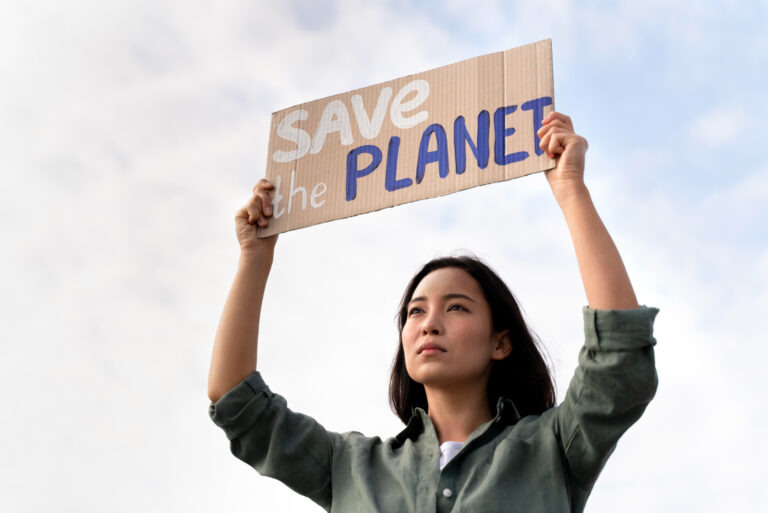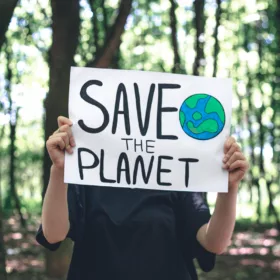On April 22, numerous initiatives around the world will celebrate our planet during Earth Day 2024. As always, it will be an opportunity to reflect on climate change and the actions we can take to try to limit it. The first question to ask then becomes: how is the Earth and what is the state of the global climate in 2023?
2023 stands out as the hottest year ever recorded by far, with a temperature exceeding 1.45 ± 0.12°C compared to the pre-industrial period average (1850-1900).
This alarming data opens the World Meteorological Organization’s (WMO) annual report on the state of the global climate in 2023, and unfortunately, this is not the only negative record broken over the past year.
The report provides a comprehensive overview of the ongoing climate changes and the influence of human action on these variations. Brochesia has always valued and promoted a form of remote and sustainable collaboration that helps reduce emissions related to travel and streamline operational processes, allowing businesses to decrease their environmental impact, thanks to the potential offered by Augmented Reality. In light of the scenario outlined by the report on the state of the global climate in 2023, we are ready to accompany you on the path towards corporate sustainability.
Let’s delve into the detailed data collected, following the seven indicators identified by the WMO, as done last year.
1. The Atmosphere Situation
The increase in man-made greenhouse gas levels in the atmosphere is one of the main drivers of climate change. The collected data confirms that this increase continued in 2023. The values of the three main greenhouse gases (carbon dioxide, methane, and nitrous oxide) have indeed risen compared to the previous report:
- The atmospheric concentration of carbon dioxide (measured in parts per million – ppm) reached 417.9ppm ± 0.2, which is 150% of pre-industrial values (last year it was 415.7 ppm).
- The concentration of methane (measured in parts per billion – ppb) reached the value of 1923±2 ppb, equivalent to 266% of pre-industrial values (last year 1908 ppb).
- The concentration of nitrous oxide (ppb) reached 335.8±0.1 ppb, equal to 124% of pre-industrial levels (in the last report they were at 334.5).
2. 2023 on Land Surface
As mentioned, 2023 was the hottest year ever recorded, with an average temperature on the Earth’s surface 1.45 ± 0.12°C higher than the pre-industrial reference. A result that makes the last nine years the hottest ever. A trend also confirmed by another data point: the average temperature between 2014 and 2023 is 1.20 ± 0.12°C higher than pre-industrial values, making it the hottest ten-year period ever recorded. This increase is due not only to human and natural greenhouse gas emissions but also to the transition from La Niña to El Niño conditions during the year.
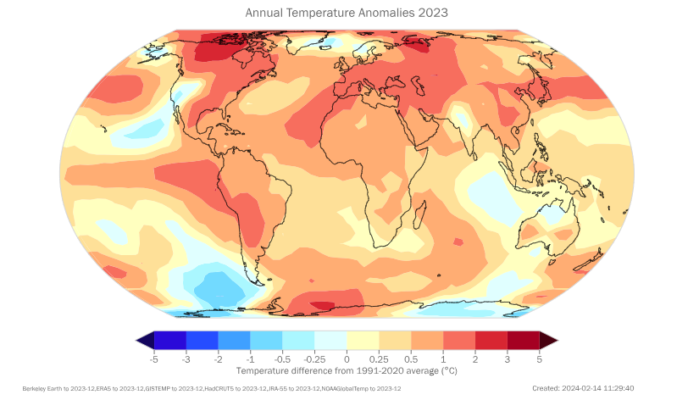
3. State of the Oceans
The heat content of the oceans also provides important details about the state of the global climate in 2023. This has indeed reached the highest value recorded in the 65 years of observation. This heat increase causes water to expand and contributes to ice melting, resulting in sea level rise. The global average sea level has reached another record since 1993 when satellite measurements began. In particular, it is noted that the global average sea level rise rate in the last ten years (2014-2023) is more than double that of the first ten years of measurements (1993-2002).
Even a few millimeters of sea level rise, although seemingly insignificant, can lead to the loss of coastal ecosystems, the destruction of coastal infrastructure, groundwater salinization, and flooding. All factors of climate change that would dramatically impact the lives of billions of people. The following graph shows some of the cities that would be affected by these problems.
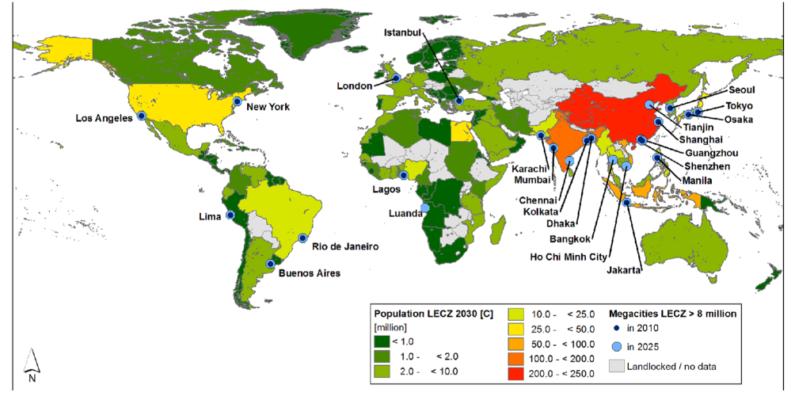
Ocean acidification continues, with a decrease in the global average pH that continues at rates not seen for at least 26,000 years. This jeopardizes not only coral reefs and marine species but also the oceans’ capacity to absorb CO2.
4. Ice Extent
Another indicator of the state of the global climate in 2023 is the presence of ice, both in the seas and on land.
Arctic sea ice remained below average throughout the year, recording the fifth lowest value for maximum extent and the sixth lowest value for minimum extent in the 45 years of satellite observation. Antarctic sea ice extent, on the other hand, reached its lowest value ever recorded on February 21, 2023. From June onwards, all values recorded were negative records. The annual maximum extent was lower than the previous record by 1 million square kilometers, a value greater than the combined extent of France and Germany.
As for glaciers, preliminary observations currently available indicate an extremely negative mass balance for Western North America and the Alps. In particular, the Swiss Alps lost about 10% of their ice volume between 2022 and 2023.
5. Extreme Weather Events
Heatwaves and cold snaps, wildfires, droughts, floods, and storms. Climate change leads to increasingly extreme weather events, and 2023 was no exception.
The Hawaiian Islands, Canada, and Europe experienced exceptional wildfires that led to loss of life, destruction of homes, and heavy air pollution. In Canada, nearly 15 million hectares burned during the year, seven times more than the annual average for the period 1986-2022, with over 235,000 people evacuated and 4 lives lost. The deadliest fires were in Hawaii, with at least 100 reported deaths.
The exceptional rainfall accompanying Mediterranean cyclone Daniel in September hit Greece, southern Bulgaria, and Turkey hard, then caused disastrous flooding in Libya, resulting in the confirmed death of 4,700 people, with another 8,000 still missing (as of December 15). There were 19 deaths in Greece and Bulgaria combined.
Tropical cyclone Freddy caused flooding in Mozambique and Malawi, resulting in casualties in both countries: 169 in Mozambique and 679 in Malawi. Tropical cyclone Mocha, on the other hand, led to the deaths of 156 people in Myanmar and the damaging or destruction of over 270,000 buildings. Hurricane Otis, in Mexico, was the event with the greatest economic impact of the year, with $12 billion in losses, 48 confirmed deaths, and 32 missing.
Heatwaves were equally significant, with southern Europe and North Africa among the hardest-hit regions. Italy saw a highest temperature of 48.2°C on July 24 in Sardinia, just 0.6°C less than the record set in Sicily in 2021. But the most impressive data for Italy comes from Milan, where the Brera Observatory recorded a daily average temperature of 32.98°C on August 23, the highest value ever recorded since 1763. Record temperatures were also recorded in Tunis (Tunisia, 49.0°C on July 24), Tirana (Albania, 43.0°C on July 25), Agadir (Morocco, 50.4°C on August 11), and Algiers (Algeria, 49.2°C on July 23).
6. Risks and Impacts of Climate Change
The increase in emissions and climate change have significant repercussions on many issues, including food security. As reported by the FAO, over 333 million people live in conditions of food insecurity, more than twice the 135 million pre-pandemic. Between 2007 and 2022,
88 studies were conducted on post-disaster environmental needs, revealing that over 65% of drought-related damage occurs in the agricultural sector, while for floods, storms, and cyclones, the figure is around 20%.
These issues particularly affected some areas in 2023:
- South Sudan: due to early-year floods, raised water levels hindered access to food, clean water, and healthcare, affecting around two-thirds of the population (7.8 million people).
- Southern Africa: with the passage of cyclone Freddy, Mozambique, Madagascar, Malawi, and Zimbabwe experienced heavy floods that damaged crops in areas still recovering from events the previous year.
- Afghanistan: reduced snowmelt in this area and lack of precipitation led to poor harvests, and between May and October, 15.3 million Afghans lived in conditions of food insecurity.
- Myanmar: the effects of cyclone Mocha, combined with intensified conflict following the 2021 coup and rising food prices, led to critical food situations for 3.4 million people.
- Indonesia: the exceptional drought that hit the country damaged over thirty thousand hectares of crops and led to a reduction in rice production of 645,000 tons.
- Mediterranean: the passage of cyclone Daniel brought record rainfall to Greece and damaged over 820 square kilometers of crops. Nearly 30% of Spanish territory was under drought alert in 2023, with the Ministry of Agriculture predicting a 40% loss in cereal crops.
Extreme weather events also created millions of displaced people worldwide, facing prohibitive conditions not only from a food perspective. These events can lead to poverty and increased social inequalities, particularly accentuated for women, due to existing gaps.
Among the areas most affected by displacement are:
- Middle East and North Africa: 3.4 million refugees and displaced people in Syria, Lebanon, Jordan, Iraq, and Egypt needed assistance to survive the winter.
- Southeast Asia: cyclone Mocha is considered one of the most disastrous events of the year for displacement among Sri Lanka, Myanmar, India, and Bangladesh. Typhoon Doksuri, on the other hand, caused 313,000 displaced people in the Philippines.
- North America: wildfires in Canada led to the evacuation of over 20,000 people, while floods in the USA created 88,000 displaced people.
- Italy: April floods in the Emilia Romagna region led to approximately 39,000 displaced people, of whom only 10,000 returned home after a week.
- Libya: the passage of cyclone Daniel, in addition to damage and casualties, led to over 43,000 displaced people.
7. What Can We Do
There is no quick fix to prevent possible disasters from increasingly extreme weather events. Therefore, the first declared goal by UN Secretary-General Antonio Guterres is to equip all populations with early warning systems, which can guarantee the possibility of seeking safety and evacuating areas that will be affected by adverse weather. Currently, one-third of the world’s population does not have these systems.
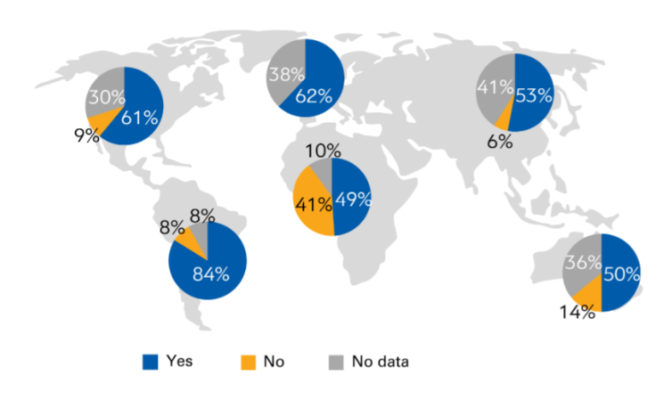
Wherever possible, we must transition to renewable energy sources, and data shows that in 2023, renewable energy production increased by 50% compared to 2022. An increase in line with the goal set by COP28.
Even so-called climate finance is increasing, with investments in the environment more than doubling in the 2021/2022 period compared to 2019/2020, reaching a total of $1.3 trillion. However, to stay within the 1.5°C increase, we will need to invest almost six times as much, reaching $9 trillion by 2030 and adding another $10 trillion by 2050.
These are the state of the global climate in 2023 and our future prospects.
Without immediate action, from the smallest daily actions to long-term investments, it will be impossible to reduce greenhouse gas emissions. According to the latest report from the European Environment Agency, road transport accounts for over 22% of greenhouse gas emissions in Europe. A vehicle produces an average of 42 grams of CO2 per passenger per kilometer, while a flight produces an average of 285 grams of CO2 per passenger per kilometer.
That’s why Brochesia is at the forefront with its customers to reduce environmental impact by promoting sustainable collaboration. Our solutions B View and B Step allow companies to reduce unnecessary travel and improve operational efficiency, thereby reducing emissions. But not only that: Brochesia software is also used to facilitate installations and maintenance of renewable energy systems and operational control in plants, offering another opportunity for sustainability.
To find out more about how Brochesia can help your business become more sustainable, contact us and request a demo.
